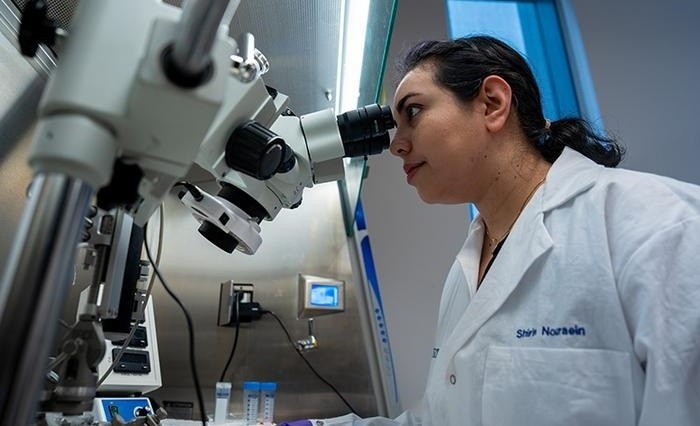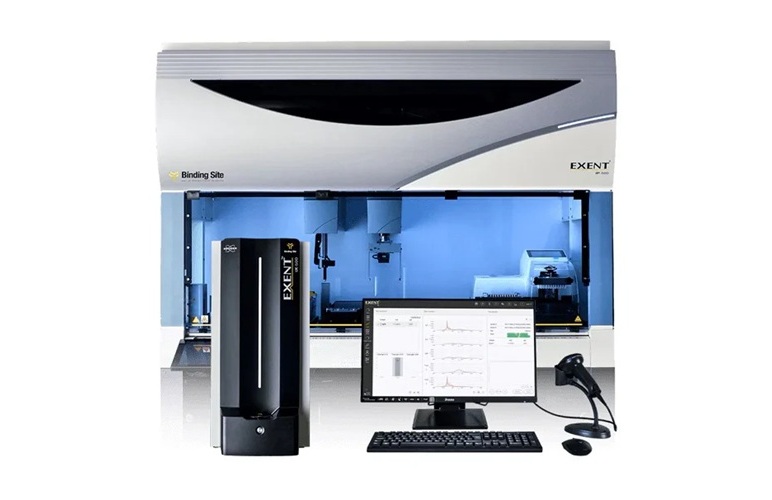Oral Bacteria May Diagnose Pancreatic Cancer
|
By LabMedica International staff writers Posted on 04 Jun 2014 |

Image: The anaerobic bacteria Leptotrichia species, Gram-stain from blood culture (Photo courtesy of Mike Dyall-Smith).
Patients with pancreatic cancer have a different and distinct profile of specific bacteria in their saliva compared to healthy controls and even patients with other cancers or pancreatic diseases.
Patients diagnosed in the early stages of pancreatic cancer have a 5-year survival rate of 21.5%, but unfortunately symptoms do not appear until after the cancer has become untreatable in the vast majority of cases.
Scientists from San Diego State University (CA, USA) compared the diversity of saliva bacteria across 131 patients, 63 females and 68 males, being treated at the University of California, San Diego (UCSD) Moores Cancer Center (La Jolla, CA, USA). Of these patients, 14 had been diagnosed with pancreatic cancer, 13 with pancreatic disease, 22 with other forms of cancer, and 10 were disease free.
The results of the study found that patients diagnosed with pancreatic cancer had higher levels of two particular oral bacteria, Leptotrichia and Campylobacter, when compared to any other healthy or diseased state including noncancerous pancreatic disease. Those with pancreatic cancer also had lower levels of Streptococcus, Treponema, and Veillonella. These findings could form the basis for a test to diagnose the pancreatic cancer in its early stages.
Pedro Torres, BS, the coauthor of the study with Scott T. Kelley, PhD, said, “Our studies suggest that ratios of particular types of bacteria found in saliva may be indicative of pancreatic cancer. The results also suggest the presence of a consistently distinct microbial profile for pancreatic cancer. We may be able to detect pancreatic cancer at its early stages by taking individuals’ saliva and looking at the ratios of these bacteria.”
In the USA, approximately 40,000 people die every year due to pancreatic adenocarcinoma, making it the fourth leading cause of cancer related death. The study was presented on May 18, 2014, at the Annual meeting of the American Society for Microbiology held May 17–20, 2014, in Boston (MA, USA).
Related Links:
San Diego State University
Moores Cancer Center
Patients diagnosed in the early stages of pancreatic cancer have a 5-year survival rate of 21.5%, but unfortunately symptoms do not appear until after the cancer has become untreatable in the vast majority of cases.
Scientists from San Diego State University (CA, USA) compared the diversity of saliva bacteria across 131 patients, 63 females and 68 males, being treated at the University of California, San Diego (UCSD) Moores Cancer Center (La Jolla, CA, USA). Of these patients, 14 had been diagnosed with pancreatic cancer, 13 with pancreatic disease, 22 with other forms of cancer, and 10 were disease free.
The results of the study found that patients diagnosed with pancreatic cancer had higher levels of two particular oral bacteria, Leptotrichia and Campylobacter, when compared to any other healthy or diseased state including noncancerous pancreatic disease. Those with pancreatic cancer also had lower levels of Streptococcus, Treponema, and Veillonella. These findings could form the basis for a test to diagnose the pancreatic cancer in its early stages.
Pedro Torres, BS, the coauthor of the study with Scott T. Kelley, PhD, said, “Our studies suggest that ratios of particular types of bacteria found in saliva may be indicative of pancreatic cancer. The results also suggest the presence of a consistently distinct microbial profile for pancreatic cancer. We may be able to detect pancreatic cancer at its early stages by taking individuals’ saliva and looking at the ratios of these bacteria.”
In the USA, approximately 40,000 people die every year due to pancreatic adenocarcinoma, making it the fourth leading cause of cancer related death. The study was presented on May 18, 2014, at the Annual meeting of the American Society for Microbiology held May 17–20, 2014, in Boston (MA, USA).
Related Links:
San Diego State University
Moores Cancer Center
Latest Pathology News
- AI Tool Outperforms Doctors in Spotting Blood Cell Abnormalities
- AI Tool Rapidly Analyzes Complex Cancer Images for Personalized Treatment
- Diagnostic Technology Performs Rapid Biofluid Analysis Using Single Droplet
- Novel Technology Tracks Hidden Cancer Cells Faster
- AI Tool Improves Breast Cancer Detection
- AI Tool Predicts Treatment Success in Rectal Cancer Patients
- Blood Test and Sputum Analysis Predict Acute COPD Exacerbation
- AI Tool to Transform Skin Cancer Detection with Near-Perfect Accuracy
- Unique Immune Signatures Distinguish Rare Autoimmune Condition from Multiple Sclerosis
- Simple Optical Microscopy Method Reveals Hidden Structures in Remarkable Detail
- Hydrogel-Based Technology Isolates Extracellular Vesicles for Early Disease Diagnosis
- AI Tool Improves Accuracy of Skin Cancer Detection
- Highly Sensitive Imaging Technique Detects Myelin Damage
- 3D Genome Mapping Tool to Improve Diagnosis and Treatment of Genetic Diseases
- New Molecular Analysis Tool to Improve Disease Diagnosis
- Tears Offer Noninvasive Alternative for Diagnosing Neurodegenerative Diseases
Channels
Clinical Chemistry
view channel
Chemical Imaging Probe Could Track and Treat Prostate Cancer
Prostate cancer remains a leading cause of illness and death among men, with many patients eventually developing resistance to standard hormone-blocking therapies. These drugs often lose effectiveness... Read more
Mismatch Between Two Common Kidney Function Tests Indicates Serious Health Problems
Creatinine has long been the standard for measuring kidney filtration, while cystatin C — a protein produced by all human cells — has been recommended as a complementary marker because it is influenced... Read moreMolecular Diagnostics
view channel
New Serum Marker-Editing Strategy to Improve Diagnosis of Neurological Diseases
Tracking gene-expression changes in the brain is crucial for understanding neurological diseases, yet current monitoring tools are invasive or unable to capture subtle activity shifts over time.... Read more
World’s First Genetic Type 1 Diabetes Risk Test Enables Early Detection
Type 1 Diabetes (T1D) affects more than eight million people worldwide, with numbers expected to rise sharply. While most cases are genetically driven, only one in ten patients has a family history, making... Read moreHematology
view channel
Platelet Activity Blood Test in Middle Age Could Identify Early Alzheimer’s Risk
Early detection of Alzheimer’s disease remains one of the biggest unmet needs in neurology, particularly because the biological changes underlying the disorder begin decades before memory symptoms appear.... Read more
Microvesicles Measurement Could Detect Vascular Injury in Sickle Cell Disease Patients
Assessing disease severity in sickle cell disease (SCD) remains challenging, especially when trying to predict hemolysis, vascular injury, and risk of complications such as vaso-occlusive crises.... Read more
ADLM’s New Coagulation Testing Guidance to Improve Care for Patients on Blood Thinners
Direct oral anticoagulants (DOACs) are one of the most common types of blood thinners. Patients take them to prevent a host of complications that could arise from blood clotting, including stroke, deep... Read moreImmunology
view channel
Gene Signature Test Predicts Response to Key Breast Cancer Treatment
DK4/6 inhibitors paired with hormone therapy have become a cornerstone treatment for advanced HR+/HER2– breast cancer, slowing tumor growth by blocking key proteins that drive cell division.... Read more
Chip Captures Cancer Cells from Blood to Help Select Right Breast Cancer Treatment
Ductal carcinoma in situ (DCIS) accounts for about a quarter of all breast cancer cases and generally carries a good prognosis. This non-invasive form of the disease may or may not become life-threatening.... Read morePathology
view channelAI Tool Outperforms Doctors in Spotting Blood Cell Abnormalities
Diagnosing blood disorders depends on recognizing subtle abnormalities in cell size, shape, and structure, yet this process is slow, subjective, and requires years of expert training. Even specialists... Read more
AI Tool Rapidly Analyzes Complex Cancer Images for Personalized Treatment
Complex digital biopsy images that typically take an expert pathologist up to 20 minutes to assess can now be analyzed in about one minute using a new artificial intelligence (AI) tool. The technology... Read moreTechnology
view channel
AI Saliva Sensor Enables Early Detection of Head and Neck Cancer
Early detection of head and neck cancer remains difficult because the disease produces few or no symptoms in its earliest stages, and lesions often lie deep within the head or neck, where biopsy or endoscopy... Read more
AI-Powered Biosensor Technology to Enable Breath Test for Lung Cancer Detection
Detecting lung cancer early remains one of the biggest challenges in oncology, largely because current tools are invasive, expensive, or unable to identify the disease in its earliest phases.... Read moreIndustry
view channel
Abbott Acquires Cancer-Screening Company Exact Sciences
Abbott (Abbott Park, IL, USA) has entered into a definitive agreement to acquire Exact Sciences (Madison, WI, USA), enabling it to enter and lead in fast-growing cancer diagnostics segments.... Read more
























